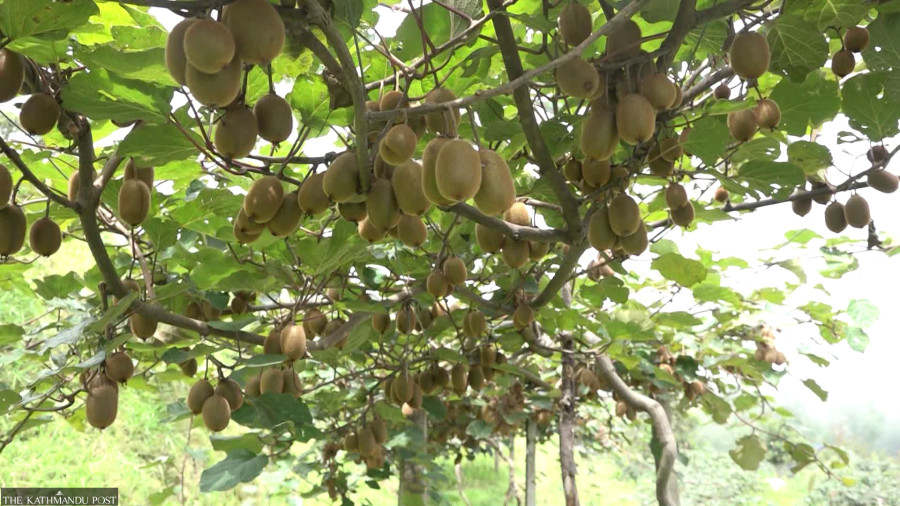Money
Kiwi farmers worried as prices plunge
Many kiwi growers have started to keep the fruit in cold storage to sell them in the off-season which yields them better income.
Kedar Shiwakoti
Anjan Budhathoki of Phasku in Dolakha has stored nearly 2 tonnes of Kiwi at his home to get a better price later in the month.
He, however, is worried that his harvest will rot because demand for the fruit has been low this season.
Farmers usually harvest Kiwi from mid-November to mid-January.
“I earned Rs700,000 by selling Kiwi last season,” said Budhathoki. “But, there is low demand in the market this year.”
Budhathoki is worried as the price of the fruit has been going down each passing year.
“The number of Kiwi farmers has grown. Along with that, there is haphazard pricing of the fruit,” said Budhathoki.
Until a decade ago, only a handful of farmers in the district knew about Kiwi.
When people in the district began commercial production of the fruit, they had hoped the market would never become an issue.
The fruit was first planted in the district by a Swiss citizen at Simpani in Charikot around three and a half decades ago.
The person, who worked on a Swiss project, stayed at Shyam Khadka’s home as a tenant.
It, however, took Khadka around two decades to know the details of the fruit.
Fifteen years ago, a firm started producing Kiwi saplings from the same tree.
“Then commercial Kiwi farming spread across the district,” said Khadka. “Along with the growth, the price is dropping and there are plenty of fruits being supplied in the market.”
Around 7,000 tonnes of Kiwi were produced in the district this year, according to Suresh Ghimire, information officer at the Prime Minister's Agriculture Modernisation Programme in the district.
“The production is expected to increase by 5,000 tonnes every year, reaching 100,000 tonnes in the next ten years.”
Kiwi with a good grading is being sold at Rs200 to Rs300 per kilo in the district, said Khadka.
But he argues planting different varieties of fruit without technical knowledge has caused a reduction in the quality.
Usually, Kiwi weighing less than 80 grams is considered low quality.

Many farmers in the district have been plucking the fruit in mid-September before it is properly ripened to send them to the market to earn a premium rate.
“But the fruit harvested between mid-November to mid-January is the best,” said Ghimire.
Currently, six varieties of Kiwi including Hayward, Alison, Monty and Bruno are grown in Dolakha.
Of them, Hayward and Alison are the most in demand.
It costs a farmer at least Rs250,000 to plant 50 saplings, according to Ghimire.
“More than 2,000 farmers in the district have been involved in the commercial production of Kiwi.”
Some farmers have also used Kiwi to make liquor when their sales are low. The marketisation issue will remain unless the government starts exporting the fruit by branding it, farmers say.
Khadka claims the consumption of Kiwi in Nepal is extremely low.
Many farmers have stored their harvest in the cold storage in Charikot as well as Kathmandu to sell it in the off-season when the price goes up.
Alok Jirel, who has 600 Kiwi trees in his orchard at Jiri Municipality-7, is one of the farmers storing the fruit.
Jirel has stored 7 tonnes in cold storage.
“I would have sold the fruit worth Rs1.5 million to Rs1.8 million by this time, but the price currently is much lower,” said Jirel.
A Kiwi tree starts producing fruits after three years of plantation. The production increases in the first 10 years and then stabilises.
A tree keeps producing the fruit for 50 years, said Ghimire.
The government has been running a Kiwi zone programme through the Prime Minister’s Agriculture Modernisation Project.
Under the programme, Kiwi is grown on 400 hectares of land in 22 wards of six local governments in the district. Around 1,100 tonnes of Kiwi have been produced in the Kiwi zone this season.
Prior to this, the Asian Development Bank had invested Rs 20 million in Kiwi farming through the Himali Project nine years ago.




 14.12°C Kathmandu
14.12°C Kathmandu













%20(1).jpg&w=300&height=200)
